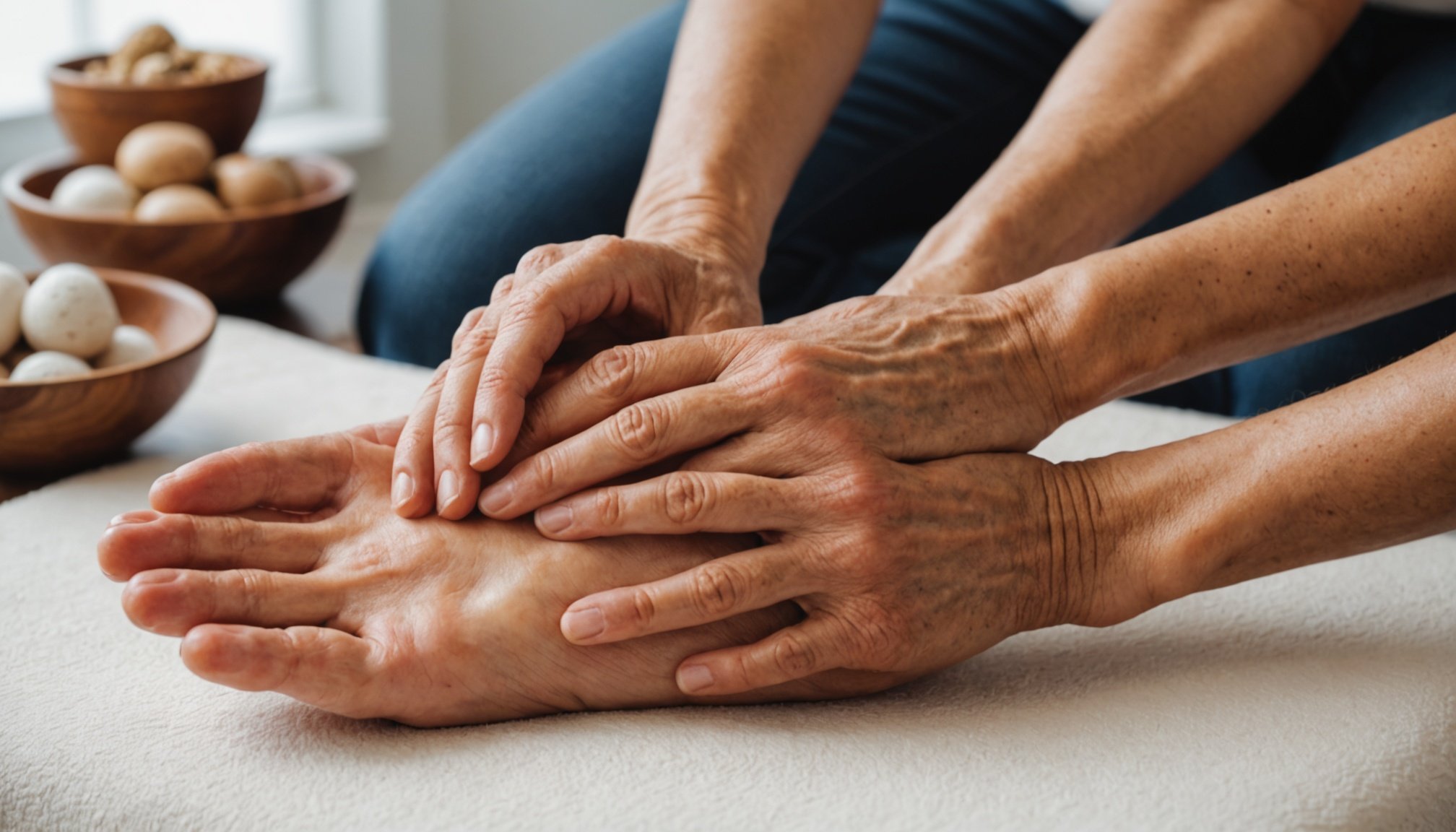Overview of Reflexology
Reflexology is an alternative therapy that involves applying pressure to specific areas on the feet, hands, and ears, called pressure points. This practice is founded on the belief that these points correspond to different organs and systems within the body. By stimulating these pressure points, reflexologists aim to promote healing and maintain wellness throughout the body.
Historically, reflexology dates back to ancient Egypt, with evidence of its practice found in tomb paintings as far back as 2330 BCE. This alternative therapy has evolved over the centuries, drawing from various cultural traditions, including Chinese and Indian medicinal practices. Modern reflexologists often integrate traditional methods with contemporary insights from medical and holistic health fields.
Additional reading : Exploring the Mental Wellness Boost: How Urban Farming Initiatives Transform Community Health
In clinical settings, reflexology techniques vary but generally involve using the thumb, fingers, and sometimes wooden sticks to apply targeted pressure. Reflexologists focus on areas such as the arches of the feet or the palms of the hands, believed to mirror the body’s different parts. Though primarily used for relaxation and stress relief, practitioners claim it can also assist with pain management and improve circulation. While scientific support varies, reflexology continues to gain popularity as a complementary approach to health and well-being.
The Role of Reflexology in Pain Management
Pain management is a critical concern, and reflexology offers a holistic approach that is gaining recognition. Reflexology involves applying pressure to specific points on the feet, hands, or ears, thought to correspond to various body systems and areas, offering potential pain relief.
Also to see : Unlocking the Mind: How Learning a New Language Boosts Cognitive Function in Older Adults
Mechanisms of Action
Reflexology is considered a non-pharmacological therapy that may disrupt pain pathways. This process involves stimulating the nervous system, promoting relaxation, and improving circulation, potentially leading to diminished pain perceptions.
Comparison with Traditional Methods
Unlike traditional medical interventions, reflexology does not rely on medication for pain relief, which can be advantageous for patients seeking alternatives to pharmaceuticals. Standard pain management often involves medications with side effects, while reflexology focuses on enhancing the body’s inherent ability to heal.
Evidence of Efficacy
Scientific studies have increasingly explored reflexology, yielding promising outcomes. Research highlights its role in reducing discomfort in conditions like arthritis and chronic back pain, endorsing it as a credible addition to pain relief strategies. Although more robust data is desirable, current findings support reflexology as a viable component of comprehensive pain management plans, especially for those interested in non-pharmacological therapies.
Reflexology in Post-Surgery Recovery for Cancer Patients
Cancer surgery presents numerous challenges, including pain management and emotional distress. Post-surgery care is thus crucial in addressing these challenges efficiently. Reflexology, a complementary therapy, plays a significant role in enhancing the recovery process for cancer patients. This ancient practice involves applying pressure to specific areas on the feet, hands, or ears that correspond to various parts of the body. This can potentially reduce stress and promote relaxation, supporting overall recovery.
Studies have indicated that reflexology offers beneficial effects post-cancer surgery. Research suggests improvements in pain relief and psychological well-being among patients undergoing cancer therapy. It aids in stimulating circulation and helping with lymphatic drainage, which may expedite healing. Moreover, it offers a non-invasive recovery support option that patients may find empowering.
Challenges can vary, including lingering aches or fatigue, but reflexology may provide a holistic approach to recovery support. It’s important for patients to communicate with their healthcare providers to integrate reflexology effectively into their post-surgery care plan. Engaging in such complementary therapies can encourage self-care, potentially improving the patient’s quality of life during their cancer therapy journey.
Reviewing Clinical Evidence
Clinical studies surrounding reflexology have long intrigued researchers, particularly in the field of pain relief. Over recent years, numerous research findings have been published, showcasing the potential benefits of reflexology as part of evidence-based practice.
Key studies primarily focus on examining whether reflexology can serve as an effective alternative for managing various kinds of pain. Results often highlight modest but consistent pain reduction in patients undergoing reflexology treatments. For example, specific interventions have shown positive outcomes in reducing chronic pain symptoms in patients with arthritis. These findings not only ease physical discomfort but also improve overall well-being.
Yet, despite these promising results, the research findings are not without limitations. Some studies suffer from small sample sizes and lack long-term follow-up, which makes it challenging to form concrete conclusions. Moreover, outcome variability between individuals indicates that reflexology might not be universally effective. As such, there’s a pressing need for more comprehensive studies with larger populations and standardized protocols to fill these gaps.
Ultimately, while reflexology shows potential as a complementary therapy, evidence-based practice must consider these limitations to guide future exploration and application.
Patient Experiences and Testimonials
Patients undergoing surgery, particularly cancer surgeries, have shared compelling feedback on the benefits of reflexology. These personal stories highlight various themes, underscoring the potential of this complementary therapy. A recurring motif in these anecdotes is the improvement in post-operative pain management. Many patients report a sense of relief and reduced discomfort following reflexology sessions, something that conventional pain management sometimes struggles to achieve.
Additionally, patients frequently note a positive impact on their overall quality of life. Reflexology, according to these experiences, not only aids in physical symptoms but also offers emotional support. Cancer patients, in particular, mention feeling calmer and more centred after sessions, which assists them in managing the stress and anxiety linked to their condition.
Another insight from patient testimonials is the enhanced sense of well-being and empowerment they experience. Reflexology, as described through personal accounts, provides a sense of control over their health journey. It often serves as a beacon of hope, underscoring the importance of psychological as well as physical healing during recovery. This feedback showcases reflexology’s valuable role in holistic health care.
Considerations for Healthcare Providers
Introducing reflexology into patient care plans can be an effective method for enhancing overall treatment. Healthcare integration is key, enabling providers to incorporate this alternative therapy strategically. Practitioners should be well-versed in the benefits and limitations of reflexology to make informed decisions when suggesting it to patients.
Training and certification are critical for ensuring quality service. Providers must verify that practitioners have the necessary credentials and are equipped to deliver reflexology safely. This vigilance protects patient safety and upholds ethical standards in healthcare. When recommending reflexology, providers must ensure that practitioners are not only certified but also experienced in working with diverse patient needs.
Provider awareness is essential for successful healthcare integration. Staying informed about recent developments in reflexology will help providers facilitate efficient patient referrals. By understanding the scope and limitations of reflexology, providers can more effectively communicate its potential benefits and risks to patients.
Finally, it’s crucial for healthcare providers to maintain open communication with patients. This dialogue helps ascertain whether reflexology aligns with individual health goals and conditions, ensuring a holistic approach to patient care that prioritises safety and efficacy.
Potential Limitations of Reflexology
Understanding therapy limitations is crucial when considering reflexology. While many find it beneficial, there are scenarios where it might not be suitable. People with specific health conditions should be cautious. For instance, individuals with fractures, active infections, or severe circulatory problems may find reflexology contraindicated. Always consult a healthcare professional before proceeding.
Patient misconceptions often arise around reflexology’s scope. Some people might mistakenly believe it can replace conventional medical treatments, leading to missed critical care.
The medical community often voices critical perspectives on reflexology. The lack of empirical evidence supporting its efficacy contributes to skepticism. Critics argue that the effects might be placebo rather than science-backed.
It’s essential to approach reflexology as a complementary therapy, not a standalone treatment. For best results, integrate it with traditional healthcare approaches. Always weigh the benefits against potential therapy limitations. Keeping an open, but informed, perspective can lead to a more balanced use of reflexology in one’s wellness routine.
Future Directions for Research
The realm of future studies in reflexology offers exciting potential, especially concerning its role in cancer care. One area ripe for exploration is the precise mechanism by which reflexology may impact therapeutic outcomes. Current research often lacks methodological rigor, leading to inconsistent results. To address this, future studies should prioritize larger sample sizes, standardized protocols, and longer follow-up periods. Another avenue is examining the specific benefits reflexology might bring as a complementary therapy alongside traditional cancer treatments. This is crucial as the landscape of alternative therapies continues to evolve.
It is also vital to establish research recommendations that focus on understanding patient-specific responses to reflexology. This includes assessing the social and psychological impacts of the therapy and identifying which patient populations might benefit most. By doing so, therapeutic innovations can be tailored to meet the unique needs of individuals living with cancer. Moreover, as we encounter advancements in the field of alternative therapies, integrating more robust evidence-based practices becomes essential in ensuring that these therapies provide safe and effective options for patients seeking holistic care solutions.











